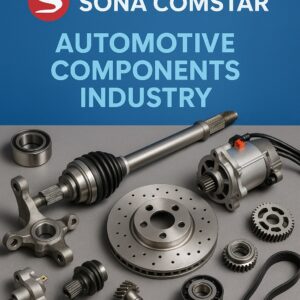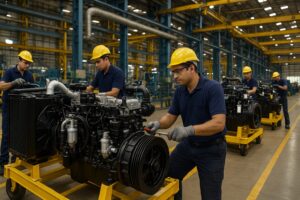Introduction
Sona BLW Precision Forgings Ltd., branded as Sona Comstar, is an Indian automotive technology company that manufactures critical components for drivetrains, electric vehicles (EVs), and internal combustion engine (ICE) vehicles. As the auto sector shifts toward electrification, companies like Sona Comstar are jockeying for leadership amid fierce competition. This review evaluates the landscape of Sona Comstar’s competitors, both in India and globally, by comparing their strategies, business models, innovation orientation, and market focus.
1. Direct Competitors Overview
Sona Comstar’s competitive set includes global and Indian players in drivetrain systems, e-axles, differential assemblies, gears, and motor solutions for electric vehicles. Its main competitors fall into three categories:
A. Global Tier-1 Suppliers
These large automotive component makers have broad portfolios and global OEM partnerships.
| Company |
Country |
Primary Overlap with Sona Comstar |
| BorgWarner Inc. |
USA |
eMotors, eAxles, power electronics |
| Valeo S.A. |
France |
Electric powertrains, motor & electronics integration |
| GKN Automotive |
UK |
Drive systems, differential assemblies, e-axles |
| Dana Inc. |
USA |
Axles, gearboxes, e-drive systems |
| Magna International |
Canada |
EV components, drivetrains, complete e-systems |
B. Indian Automotive Component Companies
These players either compete directly in EV or ICE systems or may expand into Sona’s turf.
| Company |
Focus Area |
Relevance to Sona Comstar |
| Bosch Ltd (India) |
ICE/EV components |
Strong engineering and OEM ties |
| Minda Corporation |
Electrical and mechanical parts |
Limited but increasing EV integration |
| Endurance Technologies |
Suspension, braking, casting |
Some overlap in vehicle subsystems |
| Suprajit Engineering |
Cables and lighting |
Niche competition |
| ZF India |
Transmission & safety systems |
Strong EV alignment and OEM linkages |
2. Product & Segment Comparison
| Segment |
Sona Comstar |
Key Competitors |
| Differential Assemblies |
Major supplier for global EVs |
GKN, Dana, Magna |
| Precision Forgings & Gears |
Core competency |
Bharat Gears, GKN, ZF |
| eDrive Motors (EV) |
High-efficiency traction motors |
BorgWarner, Valeo, Dana |
| Integrated e-Axles |
Focus area for EV growth |
Dana, Magna, GKN |
| ICE components |
Gradually being phased out |
Bosch, Valeo |
Sona Comstar is unique in offering both mechanical and electrical drivetrain solutions, often in integrated formats — a trait shared only with the likes of BorgWarner and Magna.
3. Strategy & Innovation
Sona Comstar:
- Focus on EV drivetrain systems (e.g., BLDC motors, e-axles, hybrid solutions).
- 75% of order book (as of 2024) is from EV OEMs.
- R&D spend of ~4-5% of revenue.
- Deep partnerships with global OEMs like Tesla, Lucid, and Mahindra.
Key Competitors:
- BorgWarner is aggressively transitioning toward a 100% EV portfolio by 2030 (Project Charging Forward).
- Magna combines full system integration with scale, serving EV majors like GM and Ford.
- GKN focuses on lightweight, modular EV driveline platforms.
- ZF leads in intelligent driveline control systems and EV transmission integration.
- Bosch is investing in hydrogen and solid-state battery systems, alongside EVs.
Sona’s innovation advantage lies in its India-based cost efficiency combined with global design collaboration, whereas competitors like Valeo or ZF rely on scale and high-tech R&D from EU and US bases.
4. Financial Comparison (FY24 Snapshot)
| Company |
Revenue (USD) |
EBITDA Margin |
EV Revenue Share |
R&D Spend % |
Market Cap (USD) |
| Sona Comstar |
~$500 million |
~26% |
~75% |
~4.5% |
~$4.2 billion |
| BorgWarner |
~$14 billion |
~13% |
~20% |
~5% |
~$9.5 billion |
| Valeo |
~$22 billion |
~8% |
~23% |
~6.2% |
~$5.3 billion |
| Magna |
~$42 billion |
~9% |
~15% |
~5% |
~$15 billion |
| Dana Inc. |
~$10 billion |
~10% |
~18% |
~3.5% |
~$3.2 billion |
5. Strengths & Weaknesses
Sona Comstar Strengths:
- EV-focused order book.
- High profitability margins.
- Lean manufacturing model.
- Strategic OEM relationships (Tesla, Volvo, etc.).
- Agile R&D in India with global integration.
Weaknesses:
- Small size vs. global peers.
- Limited diversification outside EV/auto.
- Heavy dependence on global EV adoption pace.
- Slower entry into non-automotive electrification.
Competitor Strengths (e.g., BorgWarner, Magna):
- Global manufacturing footprint.
- Deep-pocketed R&D and tech collaborations.
- System-level solutions (e.g., entire EV drive units).
- Strong M&A-driven innovation.
Competitor Weaknesses:
- Bureaucratic scale may limit agility.
- Legacy ICE exposure drags transition speed.
- Lower profit margins vs. Sona (due to global overheads).
6. Future Outlook and Competitive Risks
Sona Comstar is well-positioned to benefit from the EV drivetrain revolution, especially in Asia and emerging markets. Its high-margin EV orders and export-focused model give it strategic leverage.
However, competitive risks include global Tier-1 suppliers vertically integrating their own EV components, possible price wars in the drivetrain segment, and technological obsolescence from next-gen battery-integrated drive systems.
If battery players like CATL or BYD expand into e-drives, all traditional suppliers including Sona may face existential competition.
SWOT Comparison Table
Sona Comstar vs. BorgWarner, Magna, Dana (as representative global peers)
| Category |
Sona Comstar |
Global Competitors (BorgWarner, Magna, Dana) |
| Strengths |
EV-focused order book (~75% revenue from EVs)
High EBITDA margins (~26%)
Agile operations and cost-efficient India-based manufacturing
Specialization in e-drive motors and precision forgings
Growing presence in export markets (North America, Europe) |
Global manufacturing footprint & deep OEM relationships
Strong R&D pipelines (5–6% of revenue)
Vertical integration across broader mobility systems
Ability to serve full EV powertrain or hybrid systems
Broad technology partnerships (e.g., with battery and software firms) |
| Weaknesses |
Smaller scale and limited global footprint
Dependence on a narrow range of high-tech EV components
Limited presence in non-automotive sectors
Limited R&D resources compared to multinationals |
Lower profit margins due to global overheads and legacy businesses
Heavily exposed to ICE legacy systems (esp. BorgWarner, Dana)
Slower organizational agility due to size
Fragmented EV strategy in some cases |
| Opportunities |
Expanding EV platforms in Asia, Europe, and emerging markets
Opportunity to move up the value chain with full e-axle integration
Partnerships with fast-growing EV OEMs
Light-weighting and NVH tech add-ons |
Full-system EV adoption in Western markets
Strategic acquisitions and joint ventures to expand EV portfolio
Integration of AI, ADAS, and battery thermal systems into existing drivetrain offerings
Aftermarket and service-based revenue streams |
| Threats |
Entry of battery makers (e.g., CATL, BYD) into drive systems
Global price competition from Chinese EV component suppliers
Customer concentration risk (Tesla, Mahindra, etc.)
Tech obsolescence (e.g., integrated motor-in-wheel tech bypassing gears) |
Agile niche players like Sona disrupting established client relationships
Rising raw material and labor costs in key manufacturing geographies
Loss of ICE business faster than EV ramp-up
Regulation-driven shifts (battery chemistries, emissions rules) changing drivetrain needs |
7. Conclusion
Sona Comstar has carved a niche among global auto suppliers by combining drivetrain engineering, electric motor production, and gearing systems under one umbrella. While global giants like BorgWarner, Magna, and Dana offer broader product ecosystems and scale, Sona’s lean structure, high EV order concentration, and margin profile make it a formidable and profitable niche player. The company’s ability to scale R&D, diversify product categories, and fend off large-cap competition will define its next decade.




